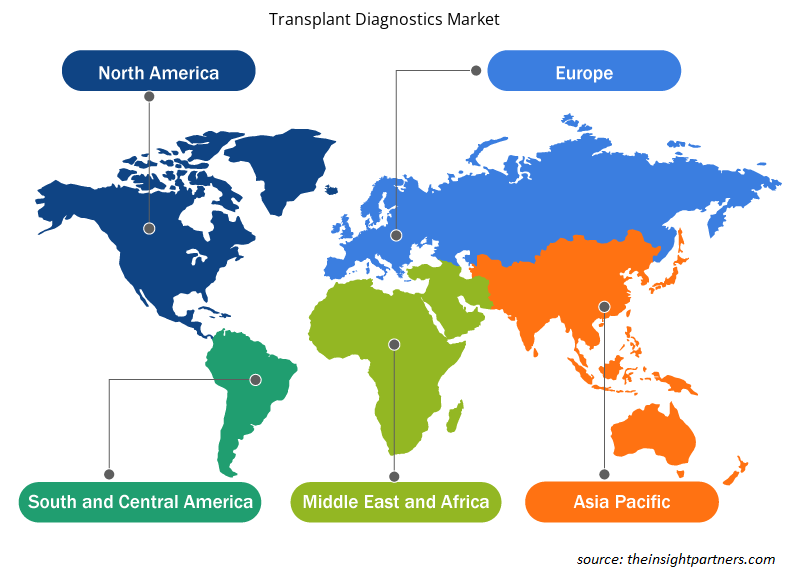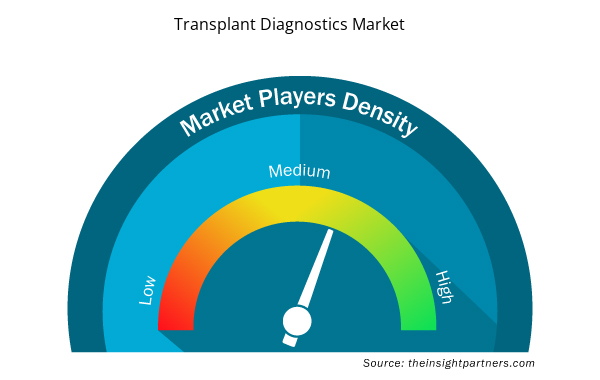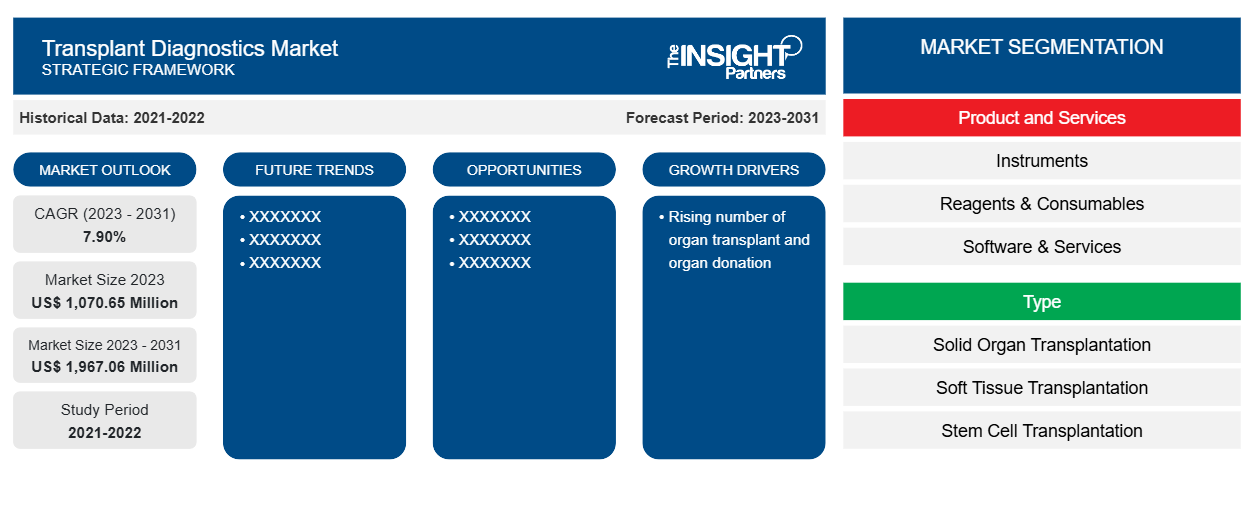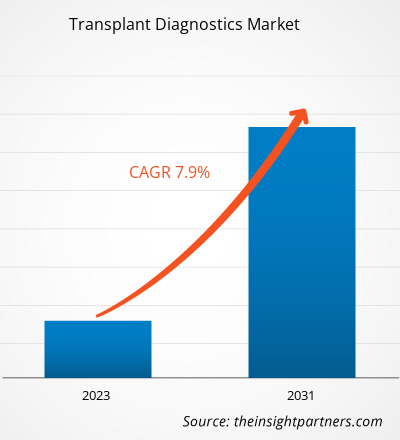La taille du marché du diagnostic de transplantation devrait atteindre 1 967,06 millions USD d'ici 2031, contre 1 070,65 millions USD en 2023. Le marché devrait enregistrer un TCAC de 7,90 % en 2023-2031. Le nombre croissant de procédures de transplantation d'organes à l'échelle mondiale, telles que les transplantations de foie, de rein, de cœur et de poumon, devrait stimuler la demande de diagnostics de transplantation, stimulant ainsi la croissance globale du marché. En outre, la prévalence croissante des défaillances d'organes et des maladies chroniques exigeant des procédures de transplantation devrait rester l'une des principales tendances du marché du diagnostic de transplantation.CAGR of 7.90% in 2023–2031. The rising number of organ transplantation procedures globally, such as liver, kidney, heart, and lung transplants, is anticipated to propel the demand for transplant diagnostics, in turn boosting the overall market growth. Additionally, the growing prevalence of organ failure and chronic diseases demanding transplantation procedures is likely to remain key transplant diagnostics market trends.
Analyse du marché du diagnostic de transplantation
La transplantation est l'un des traitements les plus prisés par les patients souffrant d'une maladie rénale et soumis à une dialyse chronique. C'est également un choix viable envisagé chez les patients souffrant d'une maladie cardiaque ou hépatique. Les diagnostics ont considérablement progressé dans le monde entier, car les entreprises ont développé de meilleures technologies de typage HLA, de surveillance des anticorps, d'instruments et de logiciels. Cette technologie est utilisée pour le diagnostic lors de la transplantation d'organes. Les progrès dans les procédures de transplantation offrent une opportunité significative de croissance du marché.HLA typing technologies, antibody monitoring, instruments, and software. This technology is being used for
Aperçu du marché du diagnostic de transplantation
L'Amérique du Nord est le plus grand marché de croissance du marché du diagnostic de transplantation, les États-Unis détenant la plus grande part de marché, suivis du Canada. La croissance en Amérique du Nord est caractérisée par l'augmentation du nombre de transplantations d'organes et par la prévalence croissante des défaillances d'organes dans cette région. Selon les données publiées sur United Network for Organ Sharing.org, on estime qu'environ 46 630 procédures de transplantation ont été réalisées en 2023 aux États-Unis. De même, selon donatelife.net, en 2022, les États-Unis ont franchi une étape historique, réalisant environ 1 million de transplantations d'organes par rapport à tout autre pays du monde. En 2023, plus de 23 000 donneurs ont redonné vie aux receveurs et à leurs familles. De plus, environ 100 000 personnes sont sur la liste d'attente pour des transplantations d'organes vitales. Ainsi, le nombre croissant de transplantations d'organes dans le pays devrait stimuler la croissance du marché dans les années à venir.Sharing.org, it is estimated that approximately 46,630 transplant procedures were carried out in the year 2023 in US. Similarly, according to donatelife.net in 2022, the US reached a historic milestone, accomplishing around 1 million organ transplants compared to any other country in the world. In 2023, more than 23,000 donors brought new life to recipients and their families. Moreover, approximately 100,000 people are on the waiting list for life-saving organ transplants. Thus, the rising number of organ transplants in the country is likely to drive market growth in the coming years.
Personnalisez ce rapport en fonction de vos besoins
Vous bénéficierez d'une personnalisation gratuite de n'importe quel rapport, y compris de certaines parties de ce rapport, d'une analyse au niveau des pays, d'un pack de données Excel, ainsi que de superbes offres et réductions pour les start-ups et les universités.
- Obtenez les principales tendances clés du marché de ce rapport.Cet échantillon GRATUIT comprendra une analyse de données, allant des tendances du marché aux estimations et prévisions.
Facteurs moteurs et opportunités du marché du diagnostic de transplantation
L'incidence croissante des maladies chroniques nécessitant des procédures de transplantation d'organes favorise le marché
Le besoin croissant de transplantations d’organes est complété par la prévalence croissante de maladies chroniques telles que le diabète et les maladies rénales, ce qui propulse encore davantage le marché des diagnostics de transplantation. Par exemple, selon les données publiées par l’Université de Californie à San Francisco, environ 750 000 patients aux États-Unis et environ 2 millions de patients dans le monde souffrent d’insuffisance rénale chaque année. Par conséquent, avec ces défaillances d’organes, le besoin de reins de donneurs aux États-Unis augmente également de 8 % par an. Des pays comme le Japon, Taïwan, le Mexique, les États-Unis et la Belgique présentent la plus forte prévalence d’insuffisance rénale.
Intégration de l’IA et de l’apprentissage automatique – Une opportunité sur le marché du diagnostic de transplantation
Une combinaison d’intelligence artificielle (IA) et d’algorithmes d’apprentissage automatique a montré des résultats prometteurs sur le marché du diagnostic de transplantation et peut améliorer les résultats des patients, accélérer l’analyse des données et augmenter la précision du diagnostic, ce qui peut entraîner une expansion du marché. La demande de transplantation a augmenté en raison de divers facteurs clés, tels que le vieillissement de la population, la prévalence croissante des maladies chroniques et les progrès des dispositifs médicaux qui permettent à un plus large éventail de patients d’être éligibles à la transplantation.
Analyse de segmentation du rapport sur le marché du diagnostic de transplantation
Les segments clés qui ont contribué à l’élaboration de l’analyse du marché du diagnostic de transplantation sont les produits et services, le type, la technologie et les utilisateurs finaux.
- Sur la base des produits et services, le marché du diagnostic de transplantation est segmenté en instruments, réactifs et consommables et logiciels et services. Instruments, réactifs et consommables et logiciels et services. Les réactifs et consommables détenaient la plus grande part du marché en 2023. Les logiciels et services ont connu le TCAC le plus élevé au cours de la période de prévision 2023-2031.CAGR over the forecast period 2023-2031.
- Par type, le marché est segmenté en transplantation d'organes solides , transplantation de tissus mous et transplantation de cellules souches. Le segment de la transplantation d'organes solides détenait la plus grande part du marché en 2023.
- En termes de technologie, le marché est segmenté en analyses moléculaires et analyses non moléculaires. Le segment des analyses moléculaires devrait enregistrer le TCAC le plus élevé au cours de la période de prévision.
- En termes d'utilisateur final, le marché est segmenté en hôpitaux et centres de transplantation, laboratoires de recherche et instituts universitaires et laboratoires de référence indépendants. Le segment des hôpitaux et des centres de transplantation détenait la plus grande part du marché en 2023.
Analyse des parts de marché du diagnostic de transplantation par géographie
La portée géographique du rapport sur le marché du diagnostic de transplantation est principalement divisée en cinq régions : Amérique du Nord, Asie-Pacifique, Europe, Moyen-Orient et Afrique, et Amérique du Sud et centrale.
L'Amérique du Nord a dominé le marché du diagnostic de transplantation. La croissance du marché peut être attribuée à une prévalence croissante de défaillance d'organes et à un nombre croissant de dons d'organes ainsi qu'à des procédures de transplantation d'organes qui alimentent la croissance du marché régional. Par exemple, selon les données publiées par l'Association of Organ Procurement Organizations (AOPO), une organisation à but non lucratif aux États-Unis, en janvier 2021, plus de 12 500 personnes ont fait don d'un ou plusieurs organes en 2020, et le nombre d'organes donnés par des donneurs décédés est passé à plus de 36 500, ce qui représente une augmentation de près de 2 % d'une année sur l'autre. De plus, les organes des morts ont sauvé plus de 33 000 vies au cours des sept dernières années.
Par conséquent, l’augmentation des dons d’organes crée le besoin d’un plus grand nombre de tests de diagnostic de transplantation et stimule ainsi la croissance du marché.
Aperçu régional du marché du diagnostic de transplantation
Les tendances et facteurs régionaux influençant le marché du diagnostic de transplantation tout au long de la période de prévision ont été expliqués en détail par les analystes d’Insight Partners. Cette section traite également des segments et de la géographie du marché du diagnostic de transplantation en Amérique du Nord, en Europe, en Asie-Pacifique, au Moyen-Orient et en Afrique, ainsi qu’en Amérique du Sud et en Amérique centrale.

- Obtenez les données régionales spécifiques au marché du diagnostic de transplantation
Portée du rapport sur le marché du diagnostic de transplantation
| Attribut de rapport | Détails |
|---|---|
| Taille du marché en 2023 | 1 070,65 millions de dollars américains |
| Taille du marché d'ici 2031 | 1 967,06 millions de dollars américains |
| Taux de croissance annuel composé mondial (2023-2031) | 7,90% |
| Données historiques | 2021-2022 |
| Période de prévision | 2023-2031 |
| Segments couverts | Par produits et services
|
| Régions et pays couverts | Amérique du Nord
|
| Leaders du marché et profils d'entreprises clés |
|
Densité des acteurs du marché : comprendre son impact sur la dynamique des entreprises
Le marché du diagnostic de transplantation connaît une croissance rapide, tirée par la demande croissante des utilisateurs finaux en raison de facteurs tels que l'évolution des préférences des consommateurs, les avancées technologiques et une plus grande sensibilisation aux avantages du produit. À mesure que la demande augmente, les entreprises élargissent leurs offres, innovent pour répondre aux besoins des consommateurs et capitalisent sur les tendances émergentes, ce qui alimente davantage la croissance du marché.
La densité des acteurs du marché fait référence à la répartition des entreprises ou des sociétés opérant sur un marché ou un secteur particulier. Elle indique le nombre de concurrents (acteurs du marché) présents sur un marché donné par rapport à sa taille ou à sa valeur marchande totale.
Les principales entreprises opérant sur le marché du diagnostic de transplantation sont :
- Laboratoires Bio-Rad,
- Hologic,
- Illumina, Inc.,
- Thermo Fisher Scientific,
- QIAGEN NV
- Omixon, Inc.
Avis de non-responsabilité : les sociétés répertoriées ci-dessus ne sont pas classées dans un ordre particulier.

- Obtenez un aperçu des principaux acteurs du marché du diagnostic de transplantation
Actualités et développements récents du marché du diagnostic de transplantation
Le marché du diagnostic de transplantation est évalué en collectant des données qualitatives et quantitatives après des recherches primaires et secondaires, qui comprennent des publications d'entreprise importantes, des données d'association et des bases de données. Voici une liste des développements sur le marché du diagnostic de transplantation :
- Thermo Fisher Scientific a ajouté deux nouveaux produits à sa gamme de diagnostics de transplantation lors de la conférence annuelle de l'American Society for Histocompatibility and Immunogenetics (ASHI). (Source : Thermo Fisher Scientific, communiqué de presse/site Web de l'entreprise/bulletin d'information, octobre 2023)
- Immucor, Inc., une société spécialisée dans le diagnostic des transfusions et des transplantations, a annoncé deux ajouts à son portefeuille de diagnostics de transplantation, démontrant ainsi son engagement continu envers de nouvelles avancées dans le domaine de l'histocompatibilité. (Source : Immucor, communiqué de presse/site Web de la société/bulletin d'information, mars 2022)
- Biocartis et Ophiomics ont conclu une collaboration visant à commercialiser HepatoPredict, un test pronostique de signature d'expression génétique permettant d'identifier les patients qui bénéficieront d'une transplantation hépatique (Source : Biocartis, Communiqué de presse/Site Internet de l'entreprise/Newsletter, mars 2022)
Rapport sur le marché du diagnostic de transplantation : couverture et livrables
Le rapport « Taille et prévisions du marché du diagnostic de transplantation (2021-2031) » fournit une analyse détaillée du marché couvrant les domaines ci-dessous :
- Taille du marché et prévisions aux niveaux mondial, régional et national pour tous les segments de marché clés couverts par le périmètre
- Dynamique du marché, comme les facteurs moteurs, les contraintes et les opportunités clés
- Principales tendances futures
- Analyse détaillée des cinq forces de PEST/Porter et SWOT
- Analyse du marché mondial et régional couvrant les principales tendances du marché, les principaux acteurs, les réglementations et les développements récents du marché
- Analyse du paysage industriel et de la concurrence couvrant la concentration du marché, l'analyse de la carte thermique, les principaux acteurs et les développements récents
- Profils d'entreprise détaillés
- Analyse historique (2 ans), année de base, prévision (7 ans) avec TCAC
- Analyse PEST et SWO
- Taille du marché Valeur / Volume - Mondial, Régional, Pays
- Industrie et paysage concurrentiel
- Ensemble de données Excel



Report Coverage
Revenue forecast, Company Analysis, Industry landscape, Growth factors, and Trends

Segment Covered
This text is related
to segments covered.

Regional Scope
North America, Europe, Asia Pacific, Middle East & Africa, South & Central America

Country Scope
This text is related
to country scope.
Trends and growth analysis reports related to Life Sciences : READ MORE..
The Insight Partners performs research in 4 major stages: Data Collection & Secondary Research, Primary Research, Data Analysis and Data Triangulation & Final Review.
- Data Collection and Secondary Research:
As a market research and consulting firm operating from a decade, we have published and advised several client across the globe. First step for any study will start with an assessment of currently available data and insights from existing reports. Further, historical and current market information is collected from Investor Presentations, Annual Reports, SEC Filings, etc., and other information related to company’s performance and market positioning are gathered from Paid Databases (Factiva, Hoovers, and Reuters) and various other publications available in public domain.
Several associations trade associates, technical forums, institutes, societies and organization are accessed to gain technical as well as market related insights through their publications such as research papers, blogs and press releases related to the studies are referred to get cues about the market. Further, white papers, journals, magazines, and other news articles published in last 3 years are scrutinized and analyzed to understand the current market trends.
- Primary Research:
The primarily interview analysis comprise of data obtained from industry participants interview and answers to survey questions gathered by in-house primary team.
For primary research, interviews are conducted with industry experts/CEOs/Marketing Managers/VPs/Subject Matter Experts from both demand and supply side to get a 360-degree view of the market. The primary team conducts several interviews based on the complexity of the markets to understand the various market trends and dynamics which makes research more credible and precise.
A typical research interview fulfils the following functions:
- Provides first-hand information on the market size, market trends, growth trends, competitive landscape, and outlook
- Validates and strengthens in-house secondary research findings
- Develops the analysis team’s expertise and market understanding
Primary research involves email interactions and telephone interviews for each market, category, segment, and sub-segment across geographies. The participants who typically take part in such a process include, but are not limited to:
- Industry participants: VPs, business development managers, market intelligence managers and national sales managers
- Outside experts: Valuation experts, research analysts and key opinion leaders specializing in the electronics and semiconductor industry.
Below is the breakup of our primary respondents by company, designation, and region:

Once we receive the confirmation from primary research sources or primary respondents, we finalize the base year market estimation and forecast the data as per the macroeconomic and microeconomic factors assessed during data collection.
- Data Analysis:
Once data is validated through both secondary as well as primary respondents, we finalize the market estimations by hypothesis formulation and factor analysis at regional and country level.
- Macro-Economic Factor Analysis:
We analyse macroeconomic indicators such the gross domestic product (GDP), increase in the demand for goods and services across industries, technological advancement, regional economic growth, governmental policies, the influence of COVID-19, PEST analysis, and other aspects. This analysis aids in setting benchmarks for various nations/regions and approximating market splits. Additionally, the general trend of the aforementioned components aid in determining the market's development possibilities.
- Country Level Data:
Various factors that are especially aligned to the country are taken into account to determine the market size for a certain area and country, including the presence of vendors, such as headquarters and offices, the country's GDP, demand patterns, and industry growth. To comprehend the market dynamics for the nation, a number of growth variables, inhibitors, application areas, and current market trends are researched. The aforementioned elements aid in determining the country's overall market's growth potential.
- Company Profile:
The “Table of Contents” is formulated by listing and analyzing more than 25 - 30 companies operating in the market ecosystem across geographies. However, we profile only 10 companies as a standard practice in our syndicate reports. These 10 companies comprise leading, emerging, and regional players. Nonetheless, our analysis is not restricted to the 10 listed companies, we also analyze other companies present in the market to develop a holistic view and understand the prevailing trends. The “Company Profiles” section in the report covers key facts, business description, products & services, financial information, SWOT analysis, and key developments. The financial information presented is extracted from the annual reports and official documents of the publicly listed companies. Upon collecting the information for the sections of respective companies, we verify them via various primary sources and then compile the data in respective company profiles. The company level information helps us in deriving the base number as well as in forecasting the market size.
- Developing Base Number:
Aggregation of sales statistics (2020-2022) and macro-economic factor, and other secondary and primary research insights are utilized to arrive at base number and related market shares for 2022. The data gaps are identified in this step and relevant market data is analyzed, collected from paid primary interviews or databases. On finalizing the base year market size, forecasts are developed on the basis of macro-economic, industry and market growth factors and company level analysis.
- Data Triangulation and Final Review:
The market findings and base year market size calculations are validated from supply as well as demand side. Demand side validations are based on macro-economic factor analysis and benchmarks for respective regions and countries. In case of supply side validations, revenues of major companies are estimated (in case not available) based on industry benchmark, approximate number of employees, product portfolio, and primary interviews revenues are gathered. Further revenue from target product/service segment is assessed to avoid overshooting of market statistics. In case of heavy deviations between supply and demand side values, all thes steps are repeated to achieve synchronization.
We follow an iterative model, wherein we share our research findings with Subject Matter Experts (SME’s) and Key Opinion Leaders (KOLs) until consensus view of the market is not formulated – this model negates any drastic deviation in the opinions of experts. Only validated and universally acceptable research findings are quoted in our reports.
We have important check points that we use to validate our research findings – which we call – data triangulation, where we validate the information, we generate from secondary sources with primary interviews and then we re-validate with our internal data bases and Subject matter experts. This comprehensive model enables us to deliver high quality, reliable data in shortest possible time.


 Obtenez un échantillon gratuit pour ce rapport
Obtenez un échantillon gratuit pour ce rapport